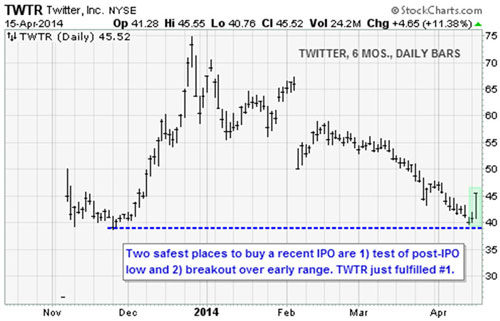 |
I hope you enjoyed a great break for Easter and Passover. Now get ready for the first-quarter earnings reporting blitz!
Almost 125 companies have reported Q1 earnings through Thursday. Of these, 65 percent have beaten earnings estimates, while only 48 percent exceeded revenue estimates. Of the 53 companies in the S&P 500 that have reported, 72 percent have beaten earnings estimates, and 54 percent had better-than-expected revenues.
It’s not new that companies are more likely to beat their earnings number than their revenue number, but it’s not an encouraging sign either. It mostly means that since the economy is just not growing much, it’s hard for companies to increase sales. So companies are focusing on financial gimmicks to increase earnings. For about the past five years skeptics have said that this is unsustainable. One day they’ll be right, but when?
Big companies that have beaten estimates the most and seen the greatest reward in their share prices so far are Citigroup (C) and General Electric (GE), with 4.3 percent and 2.1 percent pops on their report days. Worst have been IBM (IBM) and UnitedHealth (UNH), with losses of 3.4 percent and 3.5 percent on their report days, followed by Google (GOOG), at -3.2 percent.
Thursday will be the most active day for earnings this week, when more than 300 companies are expected to report, headlined by Verizon (VZ), 3M (MMM), Caterpillar (CAT), GM (GM), and Under Armor (UA) in the morning. After the bell Microsoft (MSFT), Visa (V), Starbucks (SBUX), Wynn Resorts (WYNN), Amazon.com (AMZN) and Broadcom (BRCM) will release their numbers.
The run-up to this earnings week has been quite strong, but that’s par for the course. The week before Easter has been positive for equities two-thirds of the time for the past six decades, with an average advance of 0.9 percent, and gains eight of the past nine years, according to Bespoke Investment Group data. The gain was 2 percent this year, which more than fit the bill.
It has historically been a challenge to hold onto those profits, though, as the Nasdaq typically gives up most of that ground quickly following weeks in which it rallies sharply from a multi-month low.
Until the bulls can push the Nasdaq Composite back over downtrend channel resistance near 4,150, the past week will look like nothing more than a relief rebound within the context of a broad selloff.
Indeed, investor sentiment and fund positioning have far to fall before we could label the situation panic-filled and oversold. Goldman Sachs noted this week that an analysis of U.S. fund holdings reveals a 50 percent to 90 percent overweight in the Internet and biotech plays that have been the center of attention lately.
Despite my natural optimism, it seems unlikely that the Nasdaq will get out of its current funk without at least actually touching its 200-day average, which it just barely missed nicking on Tuesday. Bespoke analysts note it has been 326 trading days since the Nasdaq has touched its 200-day average, the third-longest streak ever. The others were in 1992, 1994 and 2000.
Bespoke looked at all 25 instances when the Nasdaq went six months or more without closing below its 200-day average, then looked at performance in the first week, first month, three months and six months following that first touch. The main takeaway from the data is that the index tends to bust down through its 200-day MA with a bang, not a toe tap, with an average 2.3 percent one-day plunge. The largest was 14 years ago last week when the Naz fell 9.7 percent on its first touch of its 200-day, but 71 percent of the rest of the time it sank with at least a 1 percent impact.
Going forward, however, the typical run-out has been more sanguine, with six-month gains of 16.3 percent after that first cut through the 200-day MA, which is twice the magnitude of the average maximum drawdown during that period! In fact, the good news is that while the Nasdaq has certainly started bear markets many times with the first plunge through its 200-day average, many more times it was bears’ last hurrah before bulls took the wheel.
The bottom line of this discussion is that if and when the Naz does bust down through its 200-day, you will hear a lot of arguments that a new bear market leg has begun. But that’s not necessarily so, so don’t get too morose too soon.
And there are plenty of individual plays that will defy broad-market action.
Check out the action last week in Twitter (TWTR), for instance. It gained 11.4 percent on Tuesday for its best one-day gain since it IPO’d back in November. It still looks good here if you’re that kind of an investor, as it bounced off the level at which it first traded when it came public.
This is typically one of the best places to buy recent IPOs, as it has already been established as a shelf of value. Additionally, you can place a stop below that level, so your risk is contained. We will be talking a lot more about such tradecraft in my New Technology Superstars service in coming weeks and months.
Best wishes,
Jon


